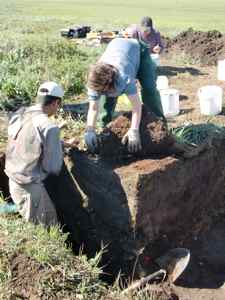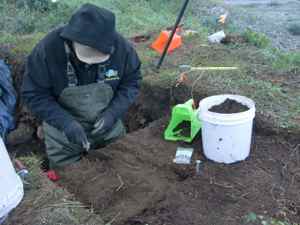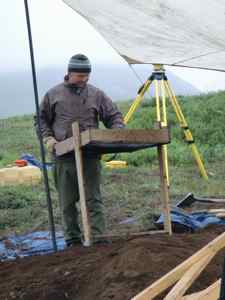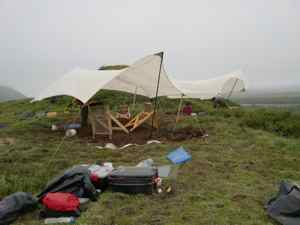Today was a great day to not be a mosquito--cold, rainy, and windy. Those poor little creatures just couldn't compete with the wind and rain. Temperatures around 50F and winds of 10-15 mph don't seem to be within their comfort zone. It was, however, just right for spending a day outside digging in the dirt and learning the fine art of archaeology. A DEET-free day!!
Yesterday, after we removed the past season's fill dirt from the site, I had my introduction to the project and the techniques we will be using as we excavate. We are working with very simple tools--trowels, buckets, and a screen mounted in a frame for sifting the dirt that is removed as we work. It's great to think that you can find artifacts that might help answer complex questions while using such simple tools. It's certainly better than using very complex equipment to answer simple questions!
We are continuing working from the excavation that was started in previous years. The dig is laid out in meter squares, so we spent yesterday creating new square meters in which to dig. This little mathematical activity is important. You need consistency as you dig to be able to compare sites and areas within the site. There are pins at each corner of the excavation that we used to create new grid squares. This is where it's handy to know how to use some basic math. We had to invoke the name of our old friend Pythagoras as we worked to make sure that our squares were really square. To do this we used two tape measures to check the sides and the diagonal between corners. Each side is 1 meter, so the diagonal is ....now it's your turn to do the math. If you really want to know, the answer will be in tomorrow's journal. See, occasionally that math stuff is pretty darn useful.
Once our squares were laid out, the work began. I am working with Steve Lanford, a BLM employee. While his interest lies in more modern sorts of archaeological pursuits like the gold rush era, he has been a great teacher of the fine art of troweling, screening, and cataloging what we find. We started out by removing the sod layer from our square meter section. Each person seemed to have a personal favorite technique. Some used a long folding saw to cut the sod free from the underlying soil and then peel the layer back. Others used a shovel to try to separate the layers. We used a small metal trenching tool with a toothed edge to cut the sod around the perimeter of our square and then to help ease it back as we rolled it neatly backwards. Neatness counts.

Once the sod layer was removed it was time to start using all the cool tools. We marked the center of the square and began to work, one quarter at a time. The excavation is laid out using a north-south grid, so each of our quarter sections is identified by their geographic orientation (NW, NE, etc). We work on one quarter-section at a time, carefully using the trowel to remove soil and placing the soil into a bucket.

Once the bucket is full, we take it over to be screened. The dirt is sifted through a screen with 1/8" diameter holes. This is small! You dump the bucket into the screen box and shake it and smush it with your hand to pass it through the holes. As you shake the screen, you remove any pieces of stone that you might find. This site contains lithics (stone tools and the bits and pieces of stone that are left around from making stone tools) and some bone. Every little bit counts, so it is important to pay attention as you screen and pull out all the pieces. All the stone bits go into a bag that is labeled with the section, the unit or square in which you are digging, and the depth of the layer in which you are working.

In addition, any piece of stone longer that 2cm is left in place and its location is identified with a computerized transit that marks and records its location. Once that information has been recorded, the piece is collected and bagged and placed with all the other little bits from that section. As we are working, we are also using a notebook to draw diagrams of the layer and mark locations of the larger stone pieces. Sometimes low-tech tools such as a pencil and paper are the best back-up.
Today we continued working on the section we began yesterday. While yesterday was sunny, warm, and somewhat breezy, today was grey, misty, rainy, and windy. Luckily we had covered up the hole last night when we stopped working so it didn't turn into a complete quagmire. This morning, we put up two tarps to cover the site while we worked. One tarp covered the site and the other covered our dirt pile and the screening area. While they didn't keep out all the wind-blown rain, they were pretty effective at providing a mostly-dry work area. These archaeologists don't let a little rain stop them. Archaeology is not for sissies.

As the day goes along, troweling, sifting, and sometimes oohing and ahhhing at pieces of stones, it's always important to remember to look up and to look around at where we are and what's around us. At one point in the afternoon I looked out to the west across the tundra and saw a largish brown lump. Musk Ox??? Nope--it was a Grizzly Bear! The bear was downwind of us and seemed fully engrossed in harvesting the blueberries that cover the tundra here. It kept moving in a trajectory that paralleled our camp and us with occasional glances in our direction. We watched until it disappeared far away in some distant willows. Yesterday we spotted a Musk Ox crossing the creek below the site while we were working. We also saw a red fox come close to our camp, probably drawn in by the smells coming from the cook tent as Nick whipped up a dinner of chicken and vegetables with Peanut Sauce. Maybe the fox likes Thai food???


Comments